Welcome to DarlingMionette's lesson! Now we will dive into the topic of clothing and folds. In this tutorial we will look at various types folds, the nature of their occurrence, and also learn how to draw clothes so that your character does not look flat like a paper figurine. You don't need any special materials for this tutorial; do you use a pencil or pen, marker, crayons or a graphic editor - doesn't matter.
First of all, let's talk about the structure of the human body. The human body is not flat, therefore, the clothes on it should not be flat either. It seems logical, but how many times have you seen clothes drawn like this?
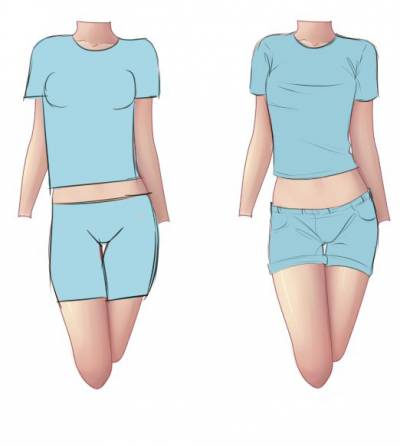
Pay attention to the picture on the left. Something's wrong here, isn't it? This is because the clothes were drawn without taking into account the body shape. What if you convert the picture into computer graphics? You don't know how because you colored the drawing incorrectly... well, what if your only problem was the clothes you were drawing? If there are no forms, then where do the shadows come from? That's it.
Now look at the picture on the right. Pay attention to how the clothes fit on the body. The curves of the clothing show the shape of the body hidden underneath. Folds are used to convey volume and movement. Converting the clothing in this drawing into CG would be much easier.
This is what my lesson will be about. Shapes, folds, and techniques that will help you learn how to choose the right clothes for your characters.
So let's start with the edge. What is an edge? Edge- This is the edge of the clothing that comes into contact with the skin. For example, in the pictures above there is a hem at the collar, at the bottom of the sleeves, at the waist of the shorts, and on the legs where the shorts touch the hips. Edges should never be straight lines because they circle the body (arms, neck, legs, belly) and body parts are voluminous. They have mass and they are rounded - so the edges of the clothes should be rounded too.
The direction of the selvage lines depends on the direction of the body part they are hugging and how the fabric falls.
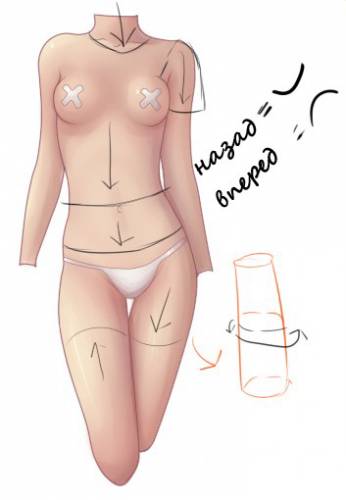
If you've already finished looking at my semi-nude model, notice the curve of the hem. To draw a hemline correctly, you need to be able to see the shape of a body part under clothing. Look at her legs, for example. Do you see the cylinder next to it? Let's imagine that her leg is a cylinder. Look how the line goes around it. There is one trick that will help you remember how the edge line should go: break the body into sections. If the bottom half of the body part that is framed by the hem of the garment is closer to the camera than the top half, then the line should rise like a rainbow. If the lower part of the body is located further from the camera than the upper part, then the edge line should bend downward, like an old rope bridge. If a part of the body stands directly perpendicular to the surface of the earth, then the line will still always bend slightly downwards, because the fabric sags under its own weight. The farther or closer to the central axis certain parts of the body are located, the more pronounced the edge line will be. Look again at my drawing above: the hemline on the legs is much more pronounced than the lines on the belly.
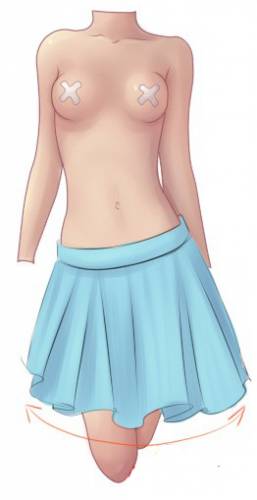
Even on non-straight edges, the line will still obey this law.
Another very important thing to know about hemlines is how they hug the body.

Look at these examples.
This applies to collars, belts, boot tops, socks... anything that goes around any part of the body and touches the skin, unless the edge is in a straight line away from the body (in which case only the fabric that goes around the body will be visible, when viewed from below). We will return to this later. Pay attention to the picture above. In the first picture the edge of the edge is quite far away from the skin, while in the second picture it is much closer. Depending on the width of the “protrusion”, you can achieve the illusion of tissue thickness. The thicker the “bump”, the thicker the fabric. In the third and fourth examples you will see the difference between loose and tight clothing. The loose fabric (example three) will recede slightly from the skin. Notice the "loop". Small hook at the end of our hem changes the thickness of the fabric, moving it outward from the skin, creating the feeling that the fabric sits loosely on the body. In the fourth example, the loop is missing (we assume this is because the hem of the garment is snug around the waist), showing that the fabric is snug against the skin.
It's a very small detail, barely noticeable, but that small area where the hem of the clothing meets the skin tells us a lot about our character's clothing (even if we don't realize it!).
So now let's go back to what I was talking about earlier, looking at the seam from the inside.

Just like the loop shown in the example above, which shows how loose the garment can fit when looking at the hem of the garment from below (as in this example), the seam will curve all the way around the body towards the back of the character. Let's go further, the skirt is made from very thin fabric, which is why the line touches the side line going down. If you wanted to show the thickness of the fabric, you should draw something like this:
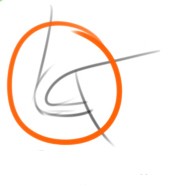
Notice the slight overlap at the hem of the skirt and how it curves toward the body, thus showing the thickness of the fabric the garment is made from.
Now, before we dive into the details of the pleats, let's talk a little about materials. Believe it or not, the material your clothes are made from greatly influences the shape of the folds they form. For example, the wool does not particularly form folds, and if it does, they turn out to be very neatly rounded and long. Satin creases very easily, but because of its silky texture, it also smooths out quickly and easily. When folds do form on it, they usually turn out to be long, wide, with very smooth, beautiful curves. Linen also creates and retains pleats easily, which is why it produces more wrinkles than other fabrics. Corduroy is very similar in its properties to wool; it forms very sharp folds, but quite rarely. It is very important to understand what material your character's clothing is made of in order to convey it correctly in the drawing. Nowadays, it is not difficult to google and find many types of fabrics to study their behavior, and I highly recommend doing this in the near future. But for those who are especially lazy... I present to you a cheat sheet:
+ Thinness and Thickness:Thin materials will wrinkle much more easily than thick materials. The folds will be located closer to each other and there will be a lot of them.
+ Silky and Rough:Silk materials do not wrinkle as easily as coarse materials, but will themselves wrinkle more often than coarse fabrics.
+ Softness and Hardness:The softer the material, the more rounded the folds will be, and the more evenly spaced they will be from each other. The harder the material, the fewer folds will form on it, and they will be large and wide.
+ Fluidity and Stiffness:Flowable materials such as silk will form long, arched folds, but there will be very few bends and the folds will be barely spaced apart. Rigid materials do not drape; they form angular, crinkled “creased pleats,” or branch out rather than form pleats. Stiff fabrics such as muslin or jute burlap will bend easily, in both small and large patterns, and the pleats will be very wide and angular.

For example, look at the picture above. Notice how the frequency, spacing, and arches of the folds reveal the type of fabric the character's clothing is made from.
Her bodice appears to be made of a thin fabric, like linen, because the pleats are numerous and of varying thicknesses, and despite the curves, the pleats have strange, sharp ends. No loop folds.
On the other hand, the waist of the dress appears to be made of a thicker, softer fabric, possibly cotton. This is because there are very few folds, in the form of tubes, and fairly equally spaced from each other.
Her skirt is very similar to a linen bodice, forming rounded pleats. It is reminiscent of soft tulle because the drape is very rounded and flattens out at the ends.
The half-ballero around her neck (though it's hard to see in this example) appears to be made of leather. There are no folds; instead, the material “bends around” the armpit and wraps around the shoulder like a loop. We can only assume that some idiot (DarlingMionette... ahem) took the time to add ruffles to this piece.
Let's move on.
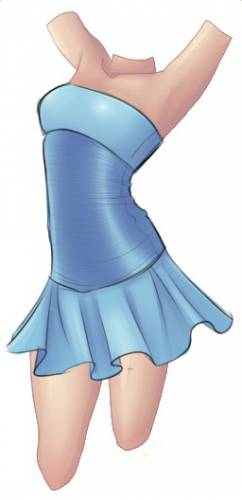
If you change the folds, the whole thing changes appearance.
The upper part of the dress resembles latex, or vinyl. There are no folds, the edges are neatly rounded.
The fabric from which the middle part of the dress is made is similar to silk. There are a few folds, but they are of different thicknesses and located close to each other.
Skirt in in this case definitely made of thick cotton. Note the large folds that are reluctant to bend.
Now, I will say again, don't forget that it is not only the type of material that affects the folds, as I said above, but also how loose or tight the fabric fits on the body and, of course, the body's movement in the garment.
Let's move on to the basic principle of creating pleats and talk about how to use them in the best way.
Tightness and Compression
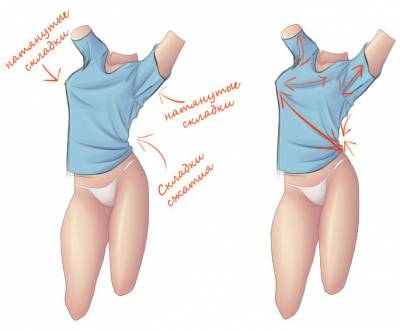
Most folds are formed by either tension or compression of the fabric.
Notice how in these examples the fabric stretches and contracts in response to body movement.
Unless the clothing is made of hard plastic or metal, wrinkles will form wherever the body pulls or squeezes the clothing. You can use these folds to highlight your character's figure. For example:

1. This fold emphasizes the shape of the chest by drawing a line underneath it and forming a smooth curve at the end of the chest.
2. Compression folds demonstrate hip elevation.
3. This is a bad fold. Why? It's initially not bad, because it emphasizes the upper part of the chest, but then it treacherously falls too low to the right, reducing the size of the chest by 1/3. Similar folds can form in real life, but we won't draw them that way. This fold should be connected to fold 4.
4. This fold correctly emphasizes the upper part of the chest, and also demonstrates the loose cut of the upper part of the top, thanks to the formed “tube”.
5. The short, curvy lines between the tops of her breasts show off the fullness of her breasts, showing the stretch of the top between her nipples.
Now let's look at the different "types" of folds
Tubular Folds
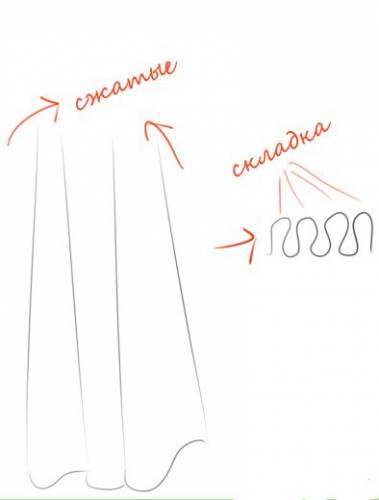
Tubular pleats are most often seen on skirts or dresses (hence the origin of pleated skirts). They form when the fabric is compressed like an accordion (like a tutu). The folds are usually cone-shaped or cylindrical. They can also form when tissue is gathered and stretched between two points.
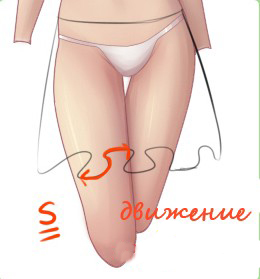
The easiest way to draw tubular pleats on a skirt or dress is to start at the bottom. Draw the edge using an S-shape motion (see example above). Form something like an accordion out of fabric.

From the longest inner point of each fold, draw a line to the waist. Don't be afraid to draw your outer folds in one direction or the other to show the movement of the fabric. It will be very boring if all the folds go up in straight lines.
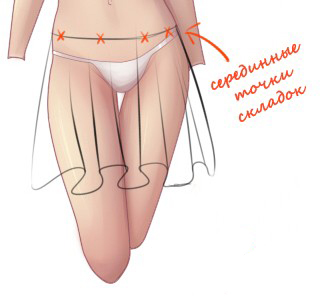
Then mark the midpoint of each fold at the waist.
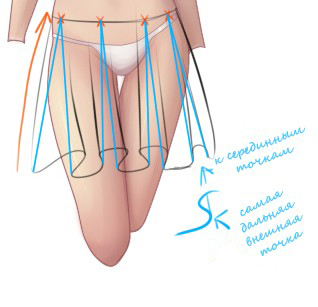
You can then connect the longest outer point at the very bottom of the folds (accordion) to the middle point to form inner part each fold.

You'll end up with something like this - a cute skirt with tubular pleats. You can adjust the height of the S-folds to change their appearance. If you want to change the direction of the tubular folds (as if you are looking at them from above), draw a line from the longest outer point of the S-curve instead of the longest inner point.
Zigzag Folds (I HATE THEM)
Zigzag folds (for me) are the most difficult element in the world to draw. I never get them right, but for this tutorial I'll try. Zigzag folds occur when fabric that is rolled into a tube (a pant leg or sleeve, for example) is compressed, thereby forming outer folds. These types of folds are more likely to form on hard fabrics.
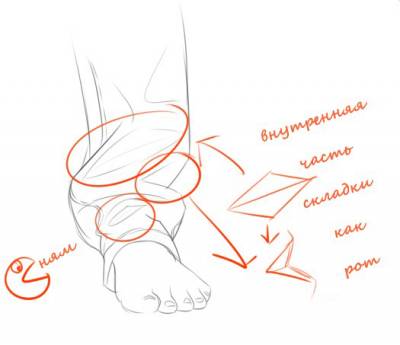
The most common place to see zigzag folds is in jeans (usually near the ankle or knee), where the fabric is compressed by the curves of the body underneath.
Notice how in this example the zigzag fold was created because the fabric itself folded into the shape of Pacman's mouth. These folds are usually diamond cut in shape.
Such folds can also be seen around the elbow.
Spiral Folds
$IMAGE18$
Similar to zigzag folds. On a softer fabric, the zigzag fold will compress into a more rounded shape (as on sleeves), creating "tubes" of the fabric.
Spiral folds are much easier to draw than zigzag folds. Simply create stripes like the zebra's body (as in the picture below the tube), and then add the outer brackets (far right picture in the picture).
These folds look good on the elbow area of the sleeves, and as a frill along the hem of the blouse.
By changing the direction of the loop folds, you can change the direction of the spirals.
Semi-closed (Hook) Folds
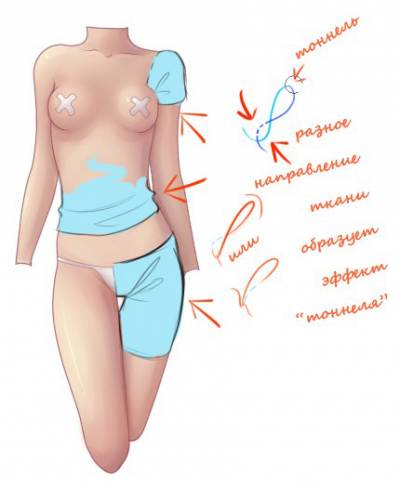
Semi-closed or hook folds are very common and can be seen almost everywhere. They are formed in those dreams where the fabric abruptly changes its direction. They are often seen around the armpits, elbows, and knees, but they can be found in other places.
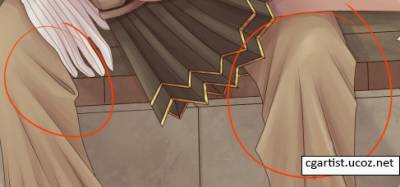
In my latest project I did for a client, I used semi-closed/hook pleats around the knees. The picture above clearly shows what semi-closed/hook folds look like from the side.
Notice how the direction between the areas of the fabric creates a sort of “tunnel” - the inside of the semi-closed/hook folds.
Their formation is very similar to the formation of Spiral and Zigzag folds.
Diamond/Drapery Pleats
Diamond or Drapery pleats, on the other hand, are created when the fabric "sags" between two supporting points. Such folds are often visible in the neckline, on mantles, and in the space between the knees when a person is sitting in a long skirt.

Notice how it "sags" between two support points (such as knees, clasps and shoulders).
The lesson is over! Hooray!
How to Draw Anime Clothes - in order to learn how to draw clothes in general, as an object, you need to apply the knowledge of academic drawing. Remember, from the first page of learning how to draw anime it was said, what- knowledge drawings will be very useful to you. This is where you need to include your knowledge of drawing or, at worst, have an idea of how it’s done. If after reading this page and some practice you feel that things are going badly, then this is the drawing guide for you. Well, we continue...
What is important here is an understanding of the formation of folds and the ability to depict them on any figure-figure a person or an anime character, it doesn’t matter.
On many sites on the topic of how to draw clothes in anime, a lot has been written about drawing folds, I don’t want to repeat myself, but whatever one may say, the ability to draw folds correctly is really important. In addition to this, we will try to add something of our own. But, for now, about the folds... The nature of the folds significantly determines certain movements of parts of the body, reveals the bending angles of forms, expresses peace, movement of the figure, air, gesture and image. The formation of folds on clothing is caused by the influence of forces on the material, causing it to move both from the inside and outside, and is subject to the general movement of the figure, emphasizing the nature of the body shape. Let's introduce the rules...
Rule 1: no crease in the form can form without a reason. So, before you mark any fold, or a line that resembles a fold, think three times whether it has a place here. If her education is justified, draw. If you don’t understand why it is needed, you draw at random - think again and outline the fold that is not formed on the form by chance. You should have an idea of how it formed on the form.
At first glance, all the folds look the same, but upon closer examination it is clear that they differ from each other primarily in the nature of their shapes. The dynamics of the formation of the nature of folds are varied and depend on the nature, properties and quality of the fabrics, the forces acting on the material, the rest of the clothing, as well as the fit of the fabrics to the form.
Classification:
Direct- folds, which are cylindrical surfaces formed by the tension force along the grain thread or by uniform sagging.
Diagonal- folds formed by the tensile force of the fabric diagonally and, as a rule, parallel.
Radial- folds extending from a fulcrum or tension point along a conical surface.
In addition to the three main ones, there is the so-called " harmonic"- diamond-shaped folds of clothing, often found at the bending points of the forms in the elbow, knee and hip joints. But everything would be fine if you really wanted to delve into the analysis of all these classifications. Even I very much doubt it. Moreover, before to get to this page, you may well have been to other sites where this has already been written about, and even more than once. So, in order to have something new for you, we will go a slightly different way and, for starters, we will launch in. move a couple more rules.
Rule 2: When drawing folds on a dressed figure, you should not reflect all the secondary folds in the drawing, but it is necessary to emphasize only the main shapes and folds characteristic of the bends, emphasizing certain movements of the figure. This way you will enhance the expressiveness of the image. You seem to lose sight of insignificant, secondary folds, generalize them without giving them any special significance. Folds should not take on too much attention and effort, distracting attention from the character. They should only beautifully complement his image.
Rule 3: When drawing clothes on a figure, you should remember that there is a shape under the clothes, especially when drawing folds. Clothes and their folds should not deform, but rather emphasize the presence of a figure under the clothes. This applies equally to drawing shoes, hats, gloves or mittens. Pay attention to the bottom (inner) part of the folds. The folds should not “cut” into the form, visually deforming it.
When drawing folds on clothes, you need to try to reveal the shape of the body, emphasizing the nature of the movement of parts of the body and the entire figure as a whole. Don't forget that folds do not exist separately from the figure.
How to Draw Anime Clothes

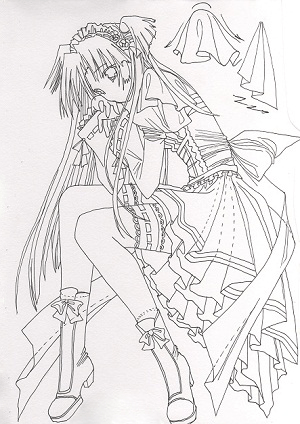 So, how to learn how to draw clothes when drawing anime characters - let's move on to practice, and, probably, we'll rush into the thick of things. In short, what is the best way or what is the best way to learn to draw clothes? How do you think? Naturally, using examples, the anime characters themselves. Everything has already been there for a long time.
So, how to learn how to draw clothes when drawing anime characters - let's move on to practice, and, probably, we'll rush into the thick of things. In short, what is the best way or what is the best way to learn to draw clothes? How do you think? Naturally, using examples, the anime characters themselves. Everything has already been there for a long time. Here you go clear example drawing folds. There is simply an abundance of folds in the arsenal of this anime drawing. To begin with, we will not delve into the topic - how to process folds with tone or color. Now you can simply learn to draw different folds separately, notice how they are formed, notice how they are built. No line should be superfluous in the drawing. If it exists, it is a formative fold. Try to constructively disassemble the fold, taking into account the presence of a form underneath it - a figure, taking into account its movement and position in space.
No unclear lines that will then need to be “painted over” according to the feel. Think, try to be a designer, draw a fold and think about how it is built and why this happens.
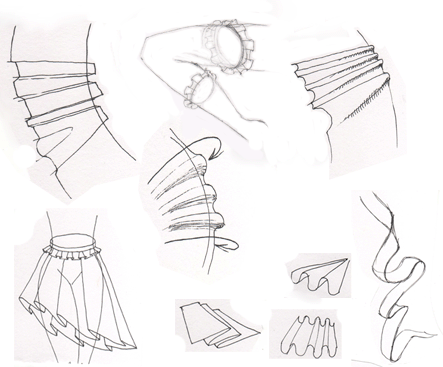 So, once again: you take a drawing with folds that you like - an example, and try to use this example to understand the formation of this or that fold. Analyze the structure of the fold, its shape, analyze what kind of fabric it is formed with - thin or dense, whether it hangs down randomly or hugs the figure, and so on.
So, once again: you take a drawing with folds that you like - an example, and try to use this example to understand the formation of this or that fold. Analyze the structure of the fold, its shape, analyze what kind of fabric it is formed with - thin or dense, whether it hangs down randomly or hugs the figure, and so on.
Dense fabric will give clearly visible “readable” folds, thin delicate fabric will give many secondary small folds, but one way or another, any line on the fold does not appear out of nowhere and does not disappear anywhere, its appearance on the fold is not accidental and forms the character of the fold itself .
The fold is at "rest" while the figure is at rest. As soon as the figure begins to move, all the folds on it begin to support its movement and begin to interact with it. Sometimes it seems that they interact somewhat in the opposite direction. Why? The figure begins to move and the folds, by inertia, gain speed gradually, somewhat delayed, but describe the direction that the figure sets. Also, when the movement stops, the folds do not immediately become static, forming new variations:

Here's something about folds, no matter what English, you can expand it to full screen mode for convenience. Let's look:
How to draw clothes for anime characters
 It's very easy to draw "CLAMP" folds. To display folds, only the main ones are used, the secondary ones are practically not used, and the movement and shape of the figure are clearly emphasized with folds. Look at how they use color: they just need to make the shaded areas—the edges of the fold—a few tones darker, and that’s it, the fold is shown. But that doesn't mean that CLAMP do it because they don't know how to draw the character's figure or creases, thus reducing the work for themselves. They still know how. You won’t be able to doubt their skill or find mistakes in their drawing.
It's very easy to draw "CLAMP" folds. To display folds, only the main ones are used, the secondary ones are practically not used, and the movement and shape of the figure are clearly emphasized with folds. Look at how they use color: they just need to make the shaded areas—the edges of the fold—a few tones darker, and that’s it, the fold is shown. But that doesn't mean that CLAMP do it because they don't know how to draw the character's figure or creases, thus reducing the work for themselves. They still know how. You won’t be able to doubt their skill or find mistakes in their drawing. If you remember the rules for drawing clothes and folds, then all three are used here: all the folds are in the drawing NOT by chance, the clothes are ON the figure, and not by themselves, and the clothes and folds EMPHASIZE the shape of the figure and the movement of its parts.
When the shape moves, the folds undergo “bending” or “unbending,” let’s call it that. In this case, the static shape of the fold can be deformed, taking on new formations - bending, tightening, overlapping, stretching, sagging. This is exactly what you need to work through, think through, study, and understand using an experimental example. Depending on the “softness” of the material itself, the folds will have a different character.
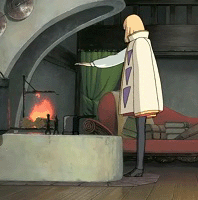
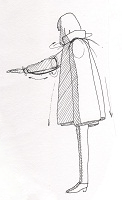 Anime master, artist with a capital letter Miyazaki Hayao. No one will doubt that he does not know how to draw a figure and those very folds. Do you think: such lightness in his works, when he barely shows the folds on the uniform, is dictated by the fact that he does not know how to draw folds? No way. He draws everything so harmoniously and intelligently that it’s hard to notice right away that everything in his drawings is constructively thought out and the clothes only emphasize the shape of the figure. It is enough for him to outline just a few folds to emphasize the image, movement, if you like, flight.
Anime master, artist with a capital letter Miyazaki Hayao. No one will doubt that he does not know how to draw a figure and those very folds. Do you think: such lightness in his works, when he barely shows the folds on the uniform, is dictated by the fact that he does not know how to draw folds? No way. He draws everything so harmoniously and intelligently that it’s hard to notice right away that everything in his drawings is constructively thought out and the clothes only emphasize the shape of the figure. It is enough for him to outline just a few folds to emphasize the image, movement, if you like, flight.
Here is the character Howl, slim figure, calmness, youth, beauty and elegance - the same features in this drawing - straight lines, clothes hanging easily from the shoulders, slimness. Do you feel how the clothes highlight the character's image? Clothes can not only emphasize what is fat or thin underneath, but also the character’s image itself. Let's look further:
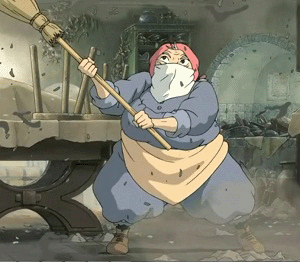
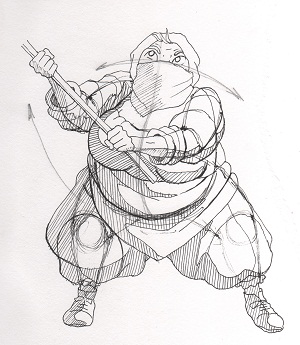 An old woman, an almost shapeless aged body, but Miyazaki does not make the drawing shapeless. Under the clothes you can clearly “read” the figure, the volume of the figure, its design. After this, the clothes themselves take on these forms, only emphasizing them. The artist introduces light and shadow elaboration: by separating the light from the shadow, the volume of the form immediately appears.
An old woman, an almost shapeless aged body, but Miyazaki does not make the drawing shapeless. Under the clothes you can clearly “read” the figure, the volume of the figure, its design. After this, the clothes themselves take on these forms, only emphasizing them. The artist introduces light and shadow elaboration: by separating the light from the shadow, the volume of the form immediately appears.
Without understanding what is under the clothes, it is very difficult to create a shadow, and it is difficult to make the figure three-dimensional. That's why you need knowledge of drawing - you need to think through and work through everything. Otherwise, all you will get from this grandmother is a cotton doll and very sad folds.
Here's more for you:
By the way, look at how Miyazaki achieves flight in his drawing. Here are the characters walking down the street, an outwardly static sight, the clothes also do not carry any extra impressions:
![]()

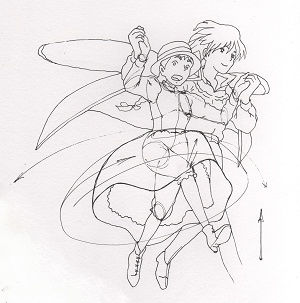 But the characters are already soaring in the clouds. See how the drawing works: the figures fly in the air, the clothes support this flight - they also soar under the influence of movement and air. The girl, moving her legs, involuntarily throws up the hem of her dress with her knees, which makes the dress look like a bell flower, and not like a hanging piece of material. Here's the connection between the movement of the character's figure and the movement of clothing. In this case, clothing emphasizes the action that is currently taking place and enhances the expressiveness of the image.
But the characters are already soaring in the clouds. See how the drawing works: the figures fly in the air, the clothes support this flight - they also soar under the influence of movement and air. The girl, moving her legs, involuntarily throws up the hem of her dress with her knees, which makes the dress look like a bell flower, and not like a hanging piece of material. Here's the connection between the movement of the character's figure and the movement of clothing. In this case, clothing emphasizes the action that is currently taking place and enhances the expressiveness of the image.
Also, you can’t say that clothes are not present on the figure. She takes exactly her place. Where it adheres to the figure, and where it receives some freedom, it emphasizes movement.
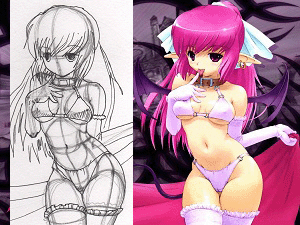
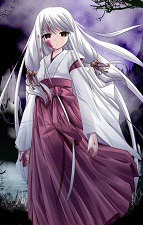 Naturally, you can use as many folds as you need when drawing clothes in anime, I am only showing the way in which you can definitely learn how to draw clothes after learning once. Starting with a few folds, continuing ad infinitum. The main thing is to feel the connection between clothes and your figure and do it understandingly.
Naturally, you can use as many folds as you need when drawing clothes in anime, I am only showing the way in which you can definitely learn how to draw clothes after learning once. Starting with a few folds, continuing ad infinitum. The main thing is to feel the connection between clothes and your figure and do it understandingly.
Look at the picture on the left - a beautiful anime heroine, what a multi-fold robe she is wearing, made of delicate silk fabric. But under this robe the volume of the figure is clearly visible. If you cannot achieve this, then perhaps you should draw an anime like this, for example, like in the picture on the right. And try, as best you can, to make out the shape of her body, feel its volume with your fingers, with the tip of a pencil. These are not only beautiful rounded shapes, with bulges and “bulges”, excuse the expression, this is a three-dimensional form that can be taken apart constructively. Having studied the volume of the figure of such an anime girl, it will be easier to dress her in clothes. If you have difficulty understanding the figure, then perhaps this will come in handy - how to draw an anime figure.
Well, after that, you can calmly just outline the folds on the clothes and go draw them in Photoshop :) Although, remembering the words of the amazing Miyazaki Hayao: “The hands that create a drawing on paper create fundamental animations.”, I would like to advise you to first work out the clothes in a constructive way and in color - conveying folds in tonal gradations - first on paper, with pencils and brushes, paints, in a word - learn to draw with pens. Only later, with the help of computer technology, having learned to control the mouse.
And here's more for you:
How to Draw Anime Clothes
 How to draw clothes in anime seems clear, but what kind of clothes to draw? If you stupidly sit at the table and “suck ideas out of your finger,” then it’s painfully difficult and you won’t be able to draw much this way, but you want something special, interesting, not like everyone else. In general, there are several ways to get inspiration.
How to draw clothes in anime seems clear, but what kind of clothes to draw? If you stupidly sit at the table and “suck ideas out of your finger,” then it’s painfully difficult and you won’t be able to draw much this way, but you want something special, interesting, not like everyone else. In general, there are several ways to get inspiration. 1. Learn to draw and paint even better by getting inspired and generating ideas from other artists. Enter a phrase into Google search, for example: “anime pictures” and you will get a lot of examples in Google images from which you can learn. Based on them, do something new, your own.
2. Naturally, each of us has favorite anime cartoons, favorite artists, characters. You can learn from these animated films, do as animators do, and develop practical skills. Based on this, produce your ideas. By the way, many topics for drawing clothes are like: school uniform, military uniforms and so on are standard, they can be used with some changes in individual details in your works, but preferably in such a way that they still reflect the “Japanese” spirit.
3. Watch all the cartoons in a row, persistently looking for ideas))) a very, very good way.
4. Use additional handy materials to find ideas on how and what kind of clothes to draw for anime. For example, modern computer games. Surely every computer has a favorite toy that you play with from time to time. For example - "SIMS", in common parlance - "family". Some people have different preferences. If you take the ideas of creating modern game characters (clothing for them), add elements of anime symbols, you can get some good characters.

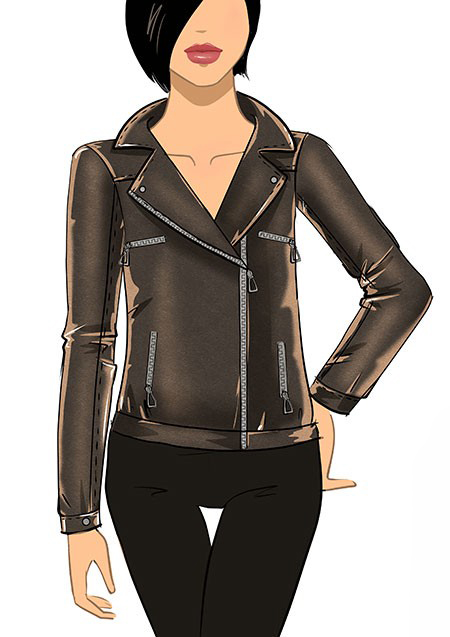
Jacket is a popular item outerwear, both for women and men. It is always relevant, and a particular model is made fashionable by details: cut, color, material or decoration. There are many types of jackets, differing from each other in both manufacture and purpose. The ability to draw it will be useful both when preparing a sketch of clothing, and for depicting a modern person, and even for children - for drawing fashionable clothes paper toys.
Step by step
First you need to figure out how to draw a jacket step by step. The most common simple model consists of a main part - a back and front, sleeves (usually with cuffs or a clasp), a collar (or hood).
Stage 1
The main part is shown. Most often, this type of outerwear has a loose fit, so it is shaped like a rectangle with a rounded top along the shoulder line. There is a wide elastic band just below the expected waistline.
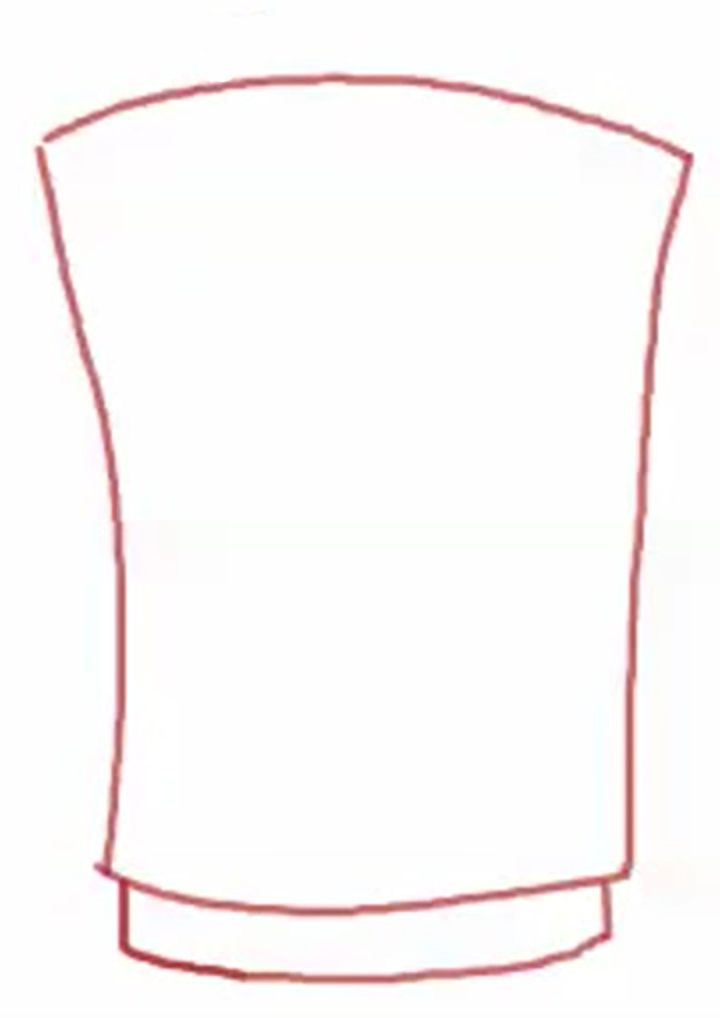
Stage 2
Sleeves, also with elastic bands or cuffs, and a collar are added to the main element. In the current simple version This is a stand-up collar. The zipper is marked.

Stage 3
At this stage, cutting details and decorations are added. For example, a chest pocket with a clasp.

Stage 4
Lastly, color is added to the picture.
Pencil

To draw a piece of clothing three-dimensionally, with all the folds and folds drawn, you can use a simple pencil. The method, at first glance, is not the simplest, but it will allow you to depict clothes the way they sit on a person. Having practiced a little in accordance with the proposed sequence, the option of how to draw a jacket with a pencil will seem quite accessible and uncomplicated.
To begin with, let's depict the thing as it is located when dressed.
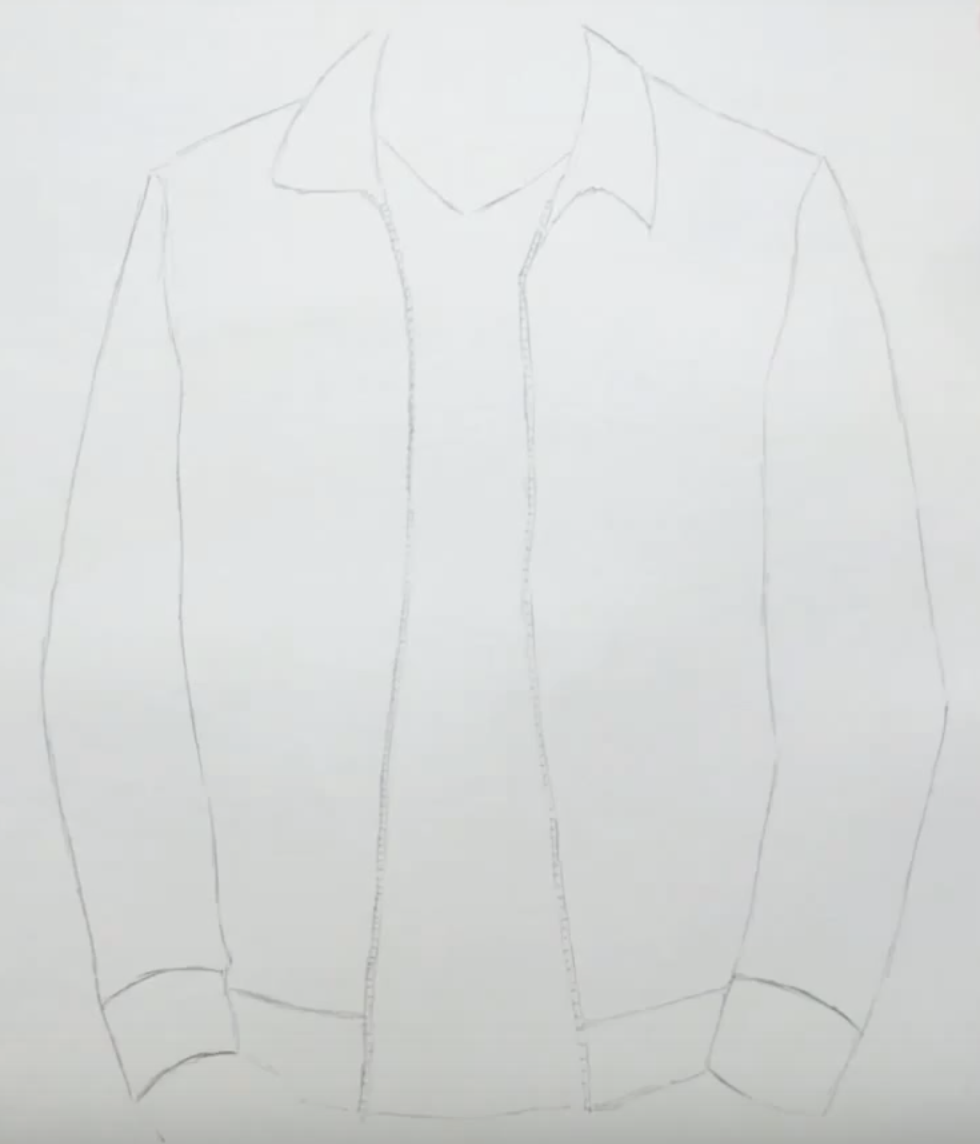
Then lines are drawn schematically, showing folds in the elbow bends and possible breaks.

Along these lines, the shadows are evenly filled in with a pencil, and sewing details are worked out: elastic, seams, fasteners, and other decorative elements.
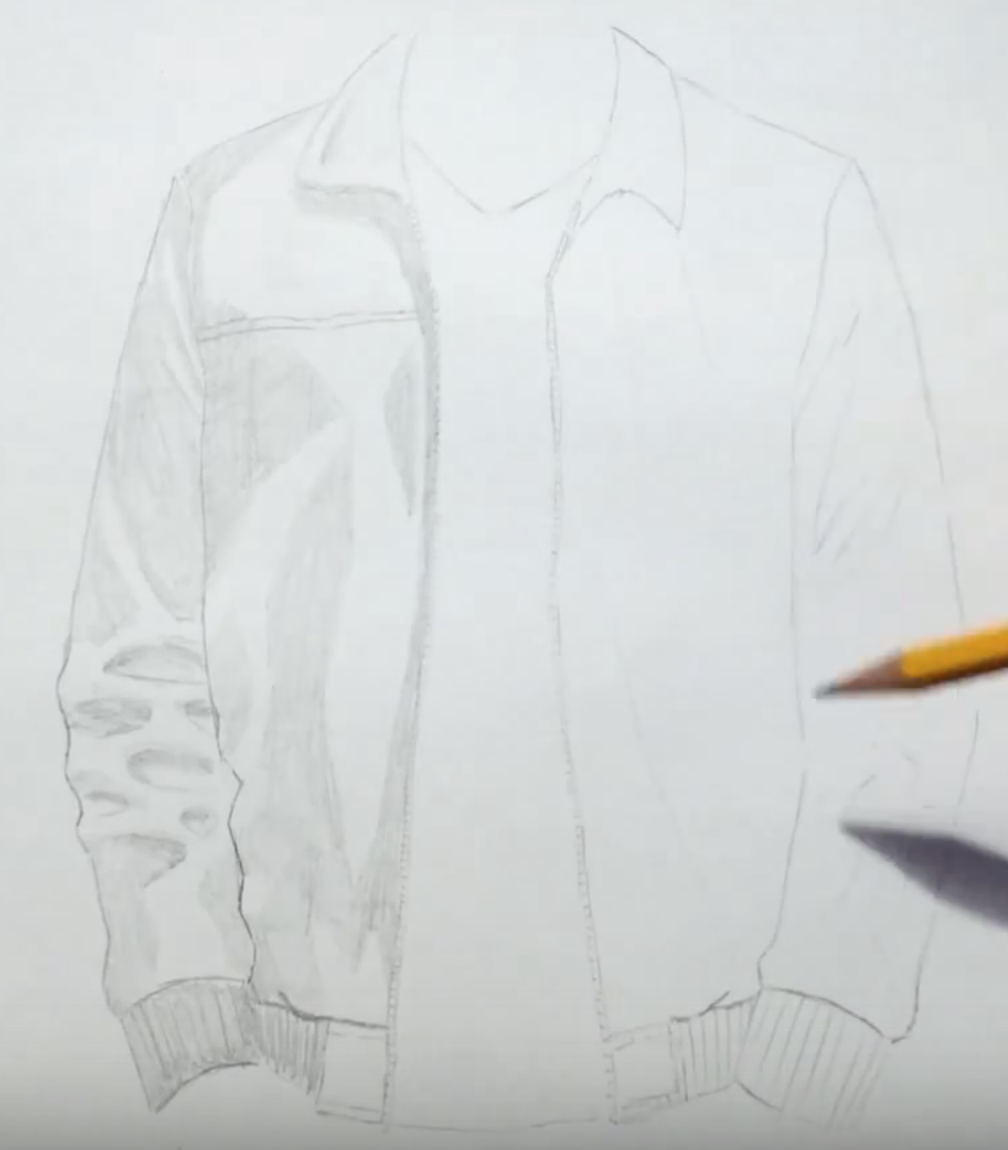
In the finale, tonal or color accents are enhanced. The clothes are ready and look very realistic.
Leather jacket

The sequence of how to draw a leather jacket is similar to the usual one, but there is slight differences in the cut, which should be taken into account when depicting this item.
To draw a girl in a jacket, it is best to first outline the model's figure. An image of clothing is superimposed on this base, taking into account the features of the cut: not fitted, just below the waist and with fairly narrow sleeves.

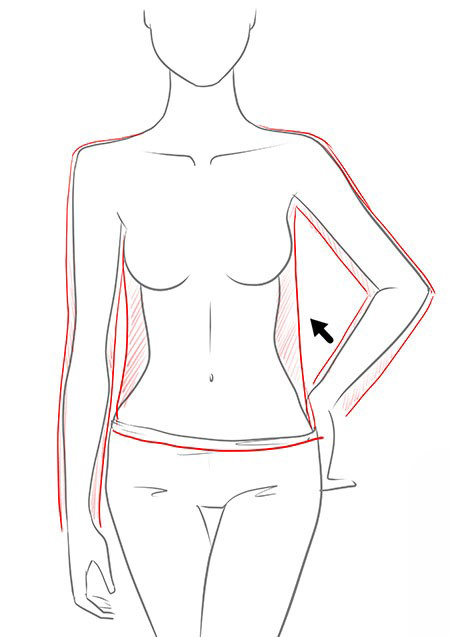
Next, the dotted line indicates the middle of the model. The jacket's clasp will be located on the right, at a distance of approximately ¼ of the width. Sleeves and cuffs are marked. Turn-down collar lines are drawn towards the clasp.


The detailed drawing of the collar begins by tracing these lines around the neck in a smooth arc, as shown in the figure. Already on this arc you should draw characteristic cutouts.
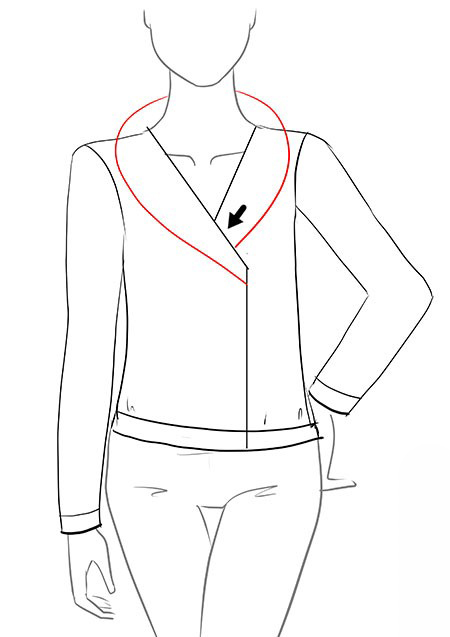
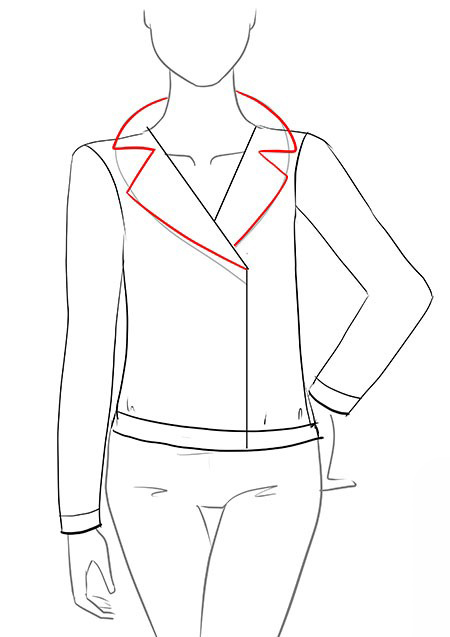
Lastly, the details of the cut and decoration are drawn: decorative seams, darts, zippers, fasteners and pockets.

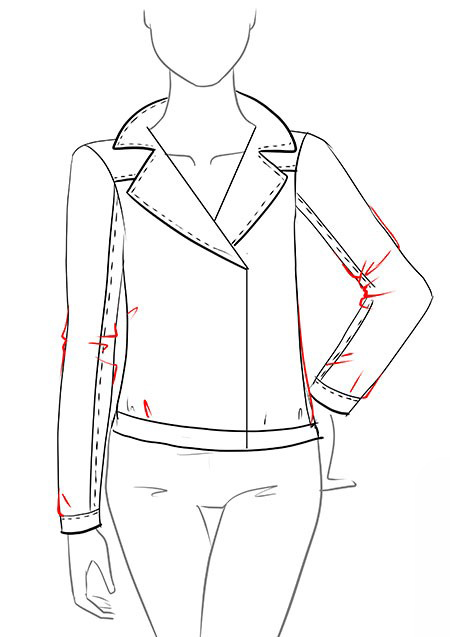

After which the finished image can be filled with color.
Leather jackets always look stylish. And it may seem that drawing a beautiful leather jacket is very difficult, but it is not so. Follow the tips and tricks from this tutorial and you will succeed.
Step 1: Draw the Shape
First, draw the figure of a girl on whom you are going to draw clothes and a jacket as well.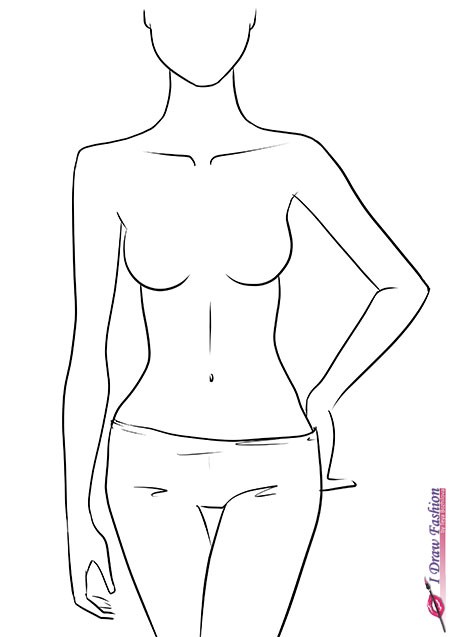
Step 2: Designate the Volume
Draw the outlines of the jacket around the girl’s figure. Please note that the jacket is not pressed tightly against the body; there should be a small space between the body and the jacket. Please note that most jackets are not very fitted, so at the waist the basic contours are similar to a box.

Step 3: Select Zipper Position
At this stage, the first thing you need to do is erase all unnecessary lines. The body under the jacket should not be visible.
A jacket with a zipper in the middle looks a little ordinary. Try drawing your leather jacket with the zipper slightly offset to the side. To do this, find the center line, and then step back a little to the right. Also mark the lines of the sleeves and the bottom of the jacket, remembering that they should be slightly rounded.
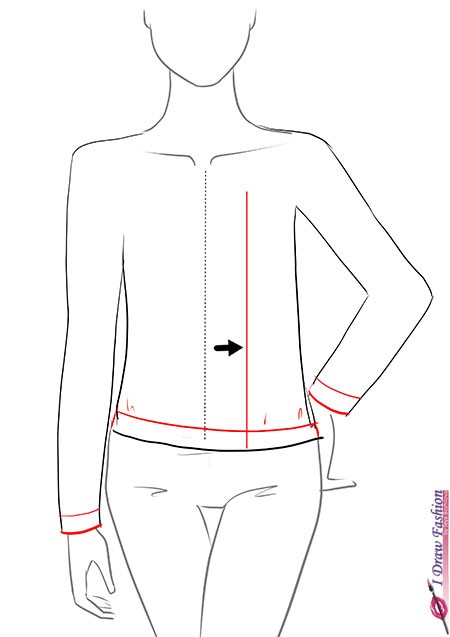
Step 4: Auxiliary Lines for the Collar
At the point where the neck and left shoulder connect, place a point and from this point draw a diagonal going towards the offset line of the lightning.
From the symmetrical point on the right, also draw a line until it intersects with the first one; it will tend to the real center line.
Use rounded lines to mark the places where the sleeves connect to the body.

Step 5: Draw the Collar
It's up to you how big you want to draw the collar. The main thing is to maintain symmetry in the relationship between the right and left sides.

Step 6: Adding Details
Now you need to “cut” two triangles on the sides from the drawn basic version of the collar. They should be located at the level of the collarbone.
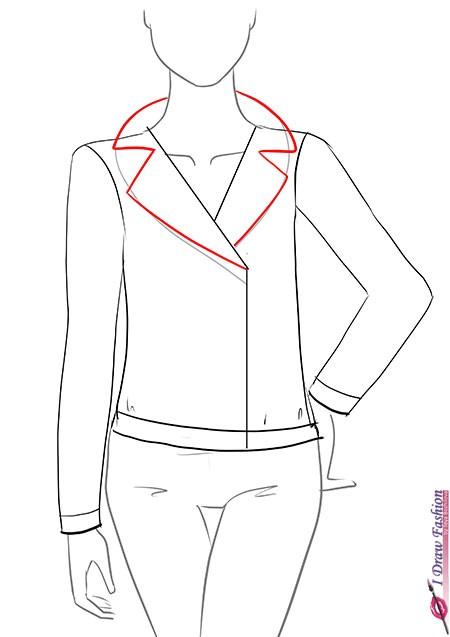
Step 7: Drawing Stitches
The detail that will help your design look like a real leather jacket is the stitching. Add stitches to the collar, inside sleeves, and bottom of the sleeves. Most leather jackets also have horizontal stitch lines just below the shoulders.
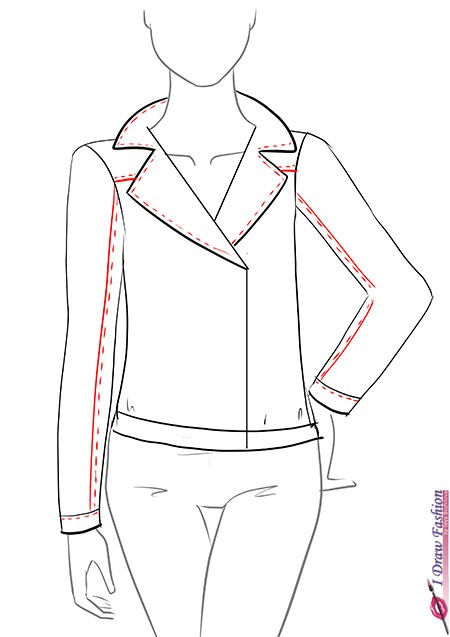
Step 8: Draw the Folds
Leather clothing has sharper folds than soft fabric clothing. Be sure to draw folds in the elbow area.
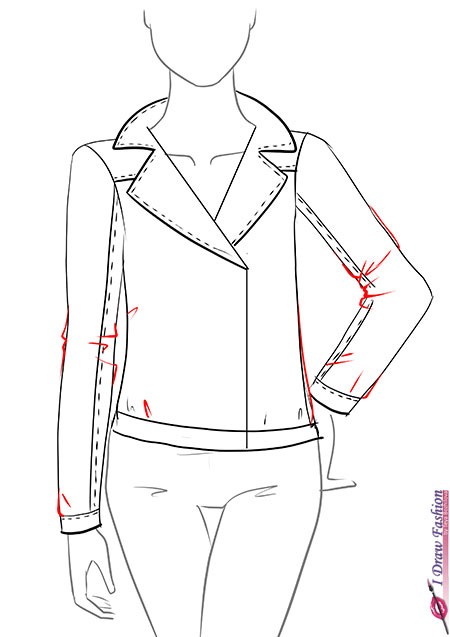
Step 9: Unique Details
Draw on the details that will make your jacket unique. These could be buttons, pockets, zippers, decorations, and so on.

Step 10: Painting
The easiest way to convey the effect of leather in a drawing is to leave lighter areas near the outline of the jacket. These areas should not be simple rectangles, they should be drawn in irregular shapes. And you don’t have to use white for this; it can be a very light tone of the main color of your jacket.
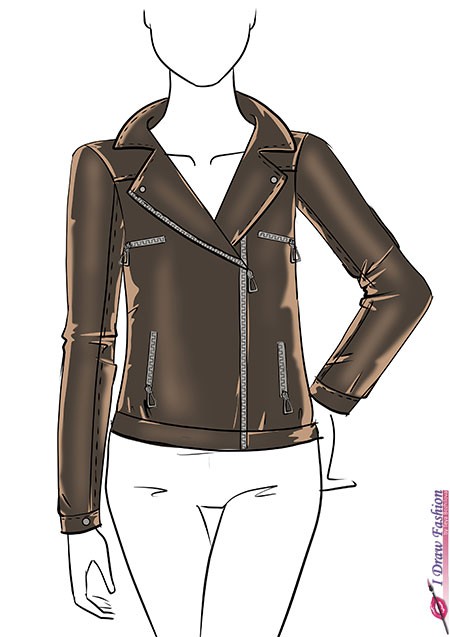
Step 11: Add Shadows
Shadows can be added using a black pencil, just lightly touching it over the surface of the drawing. Be sure to darken the areas under the collar, on the right side of the jacket, under the zippers, and the areas where you drew the folds.
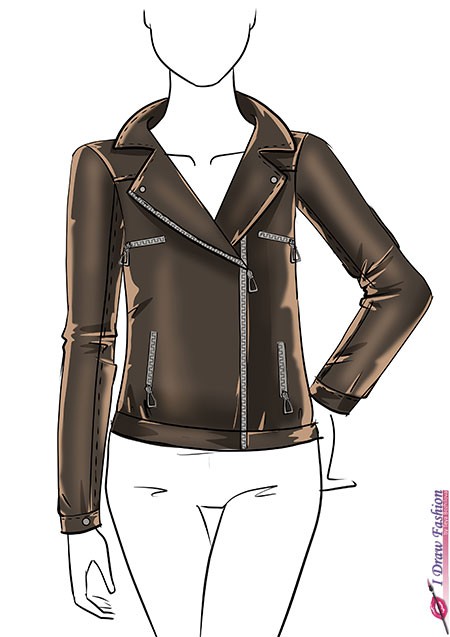
Step 12: Magic white
This step is optional, you can repeat it if you wish. Using thin white lines you can identify the brightest areas in the picture. The main thing here is not to overdo it, since a leather jacket should not be too shiny.
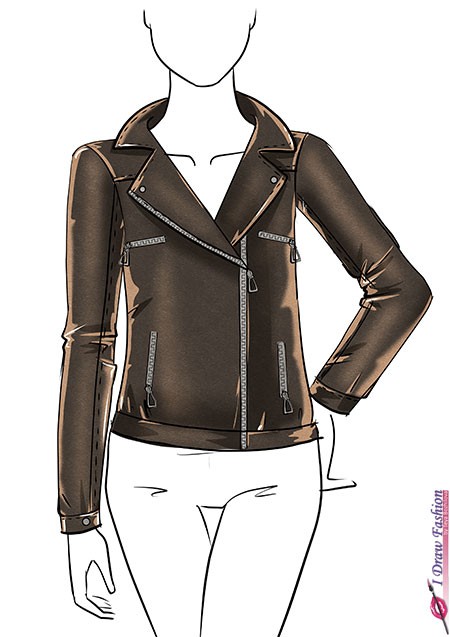
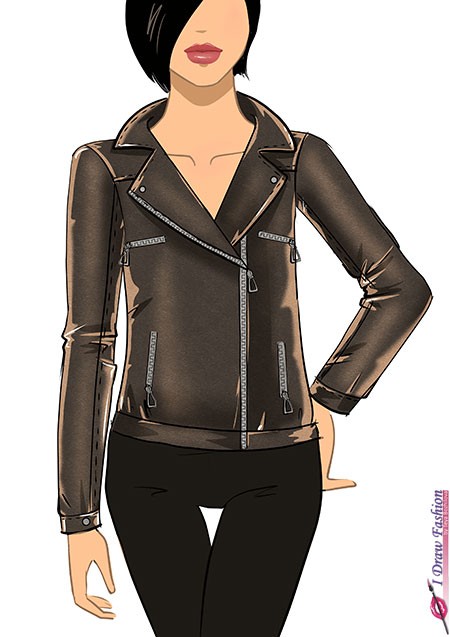
Use these tips to draw your own fashionable collection of leather outfits, or simply decorate your drawing with an interesting detail.
Happy creativity!



